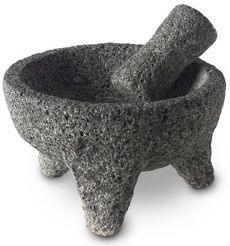 So you want real traditional Mexican Cooking?
So you want real traditional Mexican Cooking?
This is the first of a series of articles that will have you ready to do it. In writing these items about Mexican cooking, I have to give all of the credit of the information and “how to” to Rebecca Ambriz. For my part, I just enjoy her great talent in the kitchen, and translate everything to English for these pages.
Like most every Sunday, we went to her parent’s house in Palos Blancos (about a 30 minute drive from Zihua). The house is a simple structure with a sort of bathroom and two bedrooms. The front “bedroom” also serves as a kind of living room and has the TV. Throughout Mexico, this is very similar to the way a majority of the rural people live. The kitchen is outside. The kitchen consists of an open frame made from stripped tree limbs, cut off near the fork, to support smaller limbs, which in turn are covered with corrugated tar shingles.
The stove is called a chimenea. It is also supported with wood branches, but red clay has been formed on the top to create fire pits. Firewood (leña) is the source of heat. And, on top of every chimenea in Mexico, or very nearby, is a molcajete.
The origins of the molcajete go back several thousand years when Indians, all over the Americas, used a small stone to grind corn and nuts on a larger stone. With use, and due to the coarseness of what was being ground, the larger stones became bowled out. Mexico is a geographic region with lots of volcanic history. Molcajetes have been made for hundreds of years, and are currently made in several locations in the Republic.
A block of porous volcanic rock is cut and formed, creating a bowl with 3 short legs. The hand sized grinding stone (piedra) is of the same material. Surprisingly enough, after you “cure” it out, no residual grinding comes off the bowl or stone. Rebecca’s family molcajete, is more than 12 years old, and other than having been chipped a few times when it was dropped, shows no appreciable wear. And, believe me, it is used 7 days a week.
However, for your kitchen, the entire purpose for you to own a molcajete is to prepare authentic Mexican food. Otherwise, unlike rural Mexico, you would just use your food processor. The entire concept and the reason you would use one, is not because of any extra work involved. It is because a molcajete preserves the true flavors of the herbs, spices and chilies, while maintaining an unrefined texture.
The difference between making a salsa in a molcajete and, using the exact same ingredients in a blender, are worlds apart in flavor. You may also use the molcajete for grinding chilies, garlic, fresh and dried herbs, and other spices for food preparation other than Mexican food. The true flavors will be accented, and not lost.
A decent six to eight-inch molcajete can be purchased for less than $6.00 dollars in any mercado in Mexico, and it will not weigh too much for you to take it back with you. To “cure” it out, a lot of people like to first soak them in water for a few hours and then let dry. Almost everyone agrees that it is best to put a half a handful of rice in the bowl and grind it down with the stone, then rinse it out. The next step is to grind up 4 or 5 cloves of garlic, add a teaspoon each of cumin and salt, and a half teaspoon of black pepper. These are several of the basic ingredients used in Mexican cooking. They impregnate into the porous stone and are the secret to maintaining the flavors.
When you want to clean the molcajete, just rinse it under warm water and lightly scrub it with a small stiff brush. A straw brush, similar to what is used to clean a wok when cooking Chinese food, or a stiff plastic brush works well also. Do not use detergent soaps. They will absorb into the stone and will taint the flavor.
When we arrived at Rebecca’s parent’s house, her mother was getting things prepared for the mid-day meal. Rebecca’s dad had butchered a pig the day before and some of the choice portions of meat had been set aside from yesterday’s feast. Rebecca started out by making the salsa. She cut the red tomatoes in half and added them to the whole green serrano chilies and a couple of cloves of garlic on the grill (comal). When they were charred on the outside, she ground them up in the molcajete and added sea salt. The entire thing was ground up to a decent texture, and that was all there was to it.
The fresh pork was cooked and the tortillas were made (how to make the tortillas will be in the next issue). Rebecca says the flavor of food cooked on the wood burning chimenea has better flavor than on a gas stove. You would also agree, from you own experience of using a bar-b-que. And, she and I both agree Mexican salsas are better from a molcajete than a food processor.
-November 2003



